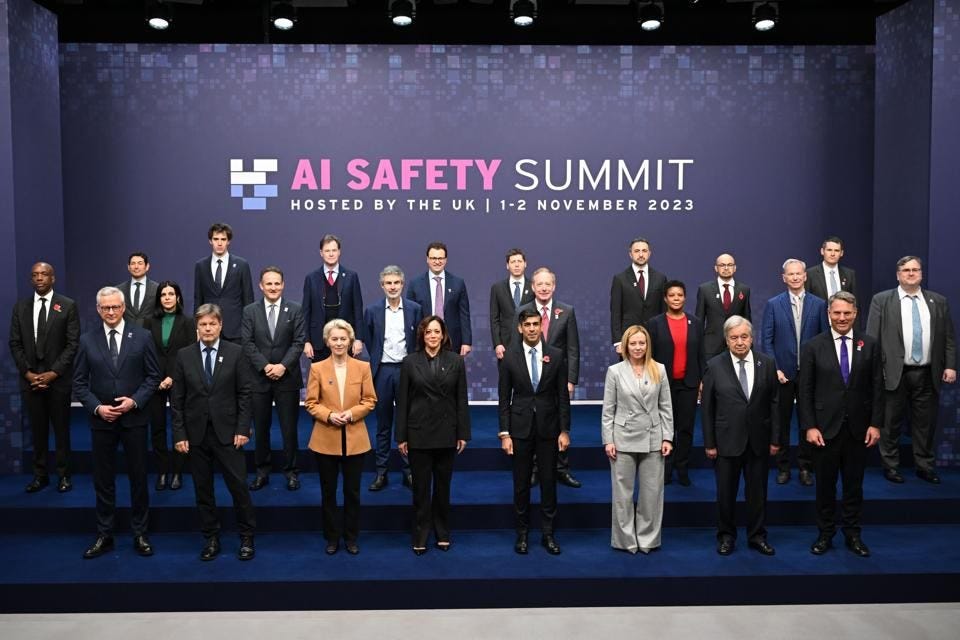HEADLINE: “China Vs. U.S.: AI Supremacy Requires Reliable Electricity” By Jude Clemente
“What McKinsey & Company calls “The Race to Power AI” boils down to the emerging struggle between the U.S. and China for supremacy in artificial intelligence (AI) and the capabilities…”
China Vs. U.S.: AI Supremacy Requires Reliable Electricity
Contributor.
I cover oil, gas, power, LNG markets, linking to human development.
Follow Author
Jun 16, 2025 at 07:03pm EDTJun 16, 2025 at 09:03pm EDT
Share
SaveComment0

What McKinsey & Company calls “The Race to Power AI” boils down to the emerging struggle between the U.S. and China for supremacy in artificial intelligence (AI) and the capabilities of its associated data centers. General estimates are that AI will increase U.S. power demand 10-20% over the next five to seven years alone. In a new report, Rocket Fuel for America’s AI Moon Shot, Dan Turner, Executive Director of Power the Future, has compared the situation to the space race between the U.S. and Russia in the 1950s and 1960s: “The race to develop artificial general intelligence will be the most significant economic and national security clash between the world’s great powers over the next generation.”
While the U.S. has a clear lead in the development of both AI and data centers, China has demonstrated its commitment to be self-reliant on these new technologies to broaden its global reach for economic, military, and national security reasons. AI requires 24/7 power, and China is rapidly putting a plan in place to assure reliable electricity that will attract and support data centers. The U.S. does not have a coherent and continuing energy plan of any type. China’s central planning allows for development and sustainability, while the U.S. approach to energy changes every four years. The fact that organization and foresight are crucial in energy planning is demonstrated by energy thinker Robert Bryce’s warning: China has a chokehold on about three dozen key elements in the Periodic Table, with an average market share of around 70% for each.
China has recommitted to its reliance on coal power. In 2024, construction began on over 94 Gigawatts (GW) of coal capacity – the most since 2015 and more than half of the U.S. existing coal fleet. The Global Energy Monitor reportsthat China has 58 GW of coal announced, 158 GW in permitting, 204 GW under construction, and 1,171 GW operating, for a grand total of 1,591 GW of coal. This is more than the entire electricity generation capacity of the EU and Japan combined (read those two sentences again). Two points need to be emphasized: (1) the Chinese coal fleet is one of the youngest, most efficient in the world, so the existing coal units still have many decades of operation and (2) many of the mega plants the Chinese are bringing online are supercritical or ultra-supercritical facilities which produce significantly fewer emissions than standard coal plants. China leads in building advanced coal plants and is home to the most efficient units in the world.
PROMOTED
In stark contrast, the U.S. seems intent on wiping coal-based electricity from the energy landscape. Over 300 coal plants have closed since 2010, and coal generation has declined from 45% of the Nation’s power to 16% today. Most importantly, just published in April, the 2025 Annual Energy Outlook (AEO) by the U.S. Energy Information Administration (EIA) projects that from 2025 to 2035 coal generating capacity will plummet from 164 GW to only 3 GW. In concert, coal generation will decline 93% in just 10 years. This seems foolish since the U.S. has some 25-30% of the world’s coal, which is even more than China. And we already know that the U.S. natural gas industry is ready to meet this great challenge: “Chevron exec says data center gas plans 'moving very quickly.”
Lest one think the U.S. is relying on new nuclear plants to serve the baseload needs of data centers, the 2025 AEO projects both nuclear capacity and generation will decline by 2040. As Dan Turner at Power the Future points out, the Nuclear Regulatory Commission is a model of bureaucratic inefficiency. Since 1990, only five applications have been approved and only two new plants have been built: the Vogtle reactors in Georgia.
MORE FOR YOU
FBI Warns iPhone, Android Users—Do Not Reply To These Messages
Google Issues Emergency Update For All 3 Billion Chrome Users
We’re Releasing Millions Of Birds. The Ticks Are Thriving
Given this troubled history over the past 35 years, it is difficult to see nuclear making a major contribution in the next two decades unless excessive bureaucratic hurdles are rapidly eliminated. Reality check: “Trump’s Nuclear Plan Faces Major Hurdles.” Meanwhile, China currently has 58 operable reactors with a total capacity of 60 GW. At least 30 reactors, with a total capacity of 34 GW, are under construction. When it comes to winning the AI race, China means serious business: “China Unveils the World’s First AI-Powered Underwater Data Center!’’
To be fair, the EIA’s AEO does project substantial new capacity by 2040 but most of it is intermittent and non-baseload solar and wind of clear limited use to data centers without a large amount of backup batteries. And the caveat: the China chokehold looms large over this forecast: China controls 75% of solar panel manufacturing, 60% of the world’s turbine production capacity and confirmed by a May 21 headline from an EIA press release: “China dominates global trade of battery minerals.”
CEO: C-suite news, analysis, and advice for top decision makers right to your inbox.
By signing up, you agree to receive this newsletter, other updates about Forbes and its affiliates’ offerings, our Terms of Service (including resolving disputes on an individual basis via arbitration), and you acknowledge our Privacy Statement.
Sign Up
There is no doubt that President Trump has taken positive steps on both coal and nuclear, but the familiar issue of a sustainable plan remains. The President’s term ends in only three and a half years. After that, is it back to business as usual while China’s baseload coal plants accommodate for the next generation of data centers.
And finally, we must remain clear for those saying that we should rely on just wind and solar here in the U.S. This is a provably dangerous position that cannot be taken seriously. We already know that the recent power outage in Spain and Portugal has raised questions about the reliability of renewables.

Editorial StandardsReprints & Permissions
Find Jude Clemente on X.
Follow Author
Join The Conversation
Comments
0
One Community. Many Voices.
Read our community guidelines here.
See All Comments (0)
NOW PLAYING: WHAT F1 CHAMPION LEWIS HAMILTON AND MICHAEL SCHUMACHER TAUGHT NICO ROSBERG
What F1 Champion Lewis Hamilton and Michael Schumacher Taught Nico Rosberg
00:00
/
01:09
FORBES’ FEATURED VIDEO






Thank you!
This is the second time in two days that I heard the us versus china comment regarding data centers, ai.
It should be disturbing to all that this is being portrayed as "a race" between China and USA.
As in "rah! rah! We must beat china". Wake up patriots, this is not good!!
Though at first glance it seems like a good option, as in china's ahead of us in this endeavor so let's see how we can improve on it, we do NOT want to model ourselves on this horrendous system of control they've perfected.
Aside of the energy concerns involved, and they are massive, this march into ai governance is dangerous on its face. It's a system that will, for all intents and purposes, run everything, including our lives.
Social credit scores, digital currency and the like is intrusion at the highest level. Unfortunately, the technocrats are on full throttle building quickly quietly under our noses.